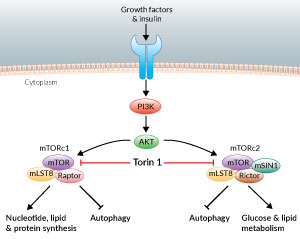Torin 1
| Product | Unit size | Cat. code | Docs. | Qty. | Price | |
|---|---|---|---|---|---|---|
|
Torin 1 mTOR inhibitor |
Show product |
10 mg 5 x 10 mg |
inh-tor1
|
|
mTOR Inhibitor and Autophagy Inducer
Torin 1 is a potent and selective ATP-competitive inhibitor of mTOR (mammalian target of Rapamycin) kinase [1]. It is the catalytic subunit of two functionally distinct complexes (mTORc1 and mTORc2) that coordinately promote cell growth, proliferation, and survival. The multi-component mTOR complexes are comprised of different binding partners that confer separate functions.
Mode of action:
Unlike classical mTOR inhibitors such as Rapamycin, Torin 1 is able to effectively block phosphorylation of mTORc1 and mTORc2 [2].
Torin 1 is an effective inducer of autophagy, as inhibition of mTOR mimics cellular starvation by blocking signals required for cell growth and proliferation [3, 4].
Interestingly, Torin 1 has also been shown to have cytotoxic and cytostatic effects in rapamycin-resistant cells [5].
Key features:
- A potent mTOR inhibitor
- Blocks phosphorylation of mTORc1 and mTORc2
- An autophagy inducer
![]() Read our review on Autophagy and Innate Immunity
Read our review on Autophagy and Innate Immunity
References:
1. Liu Q. et al., 2010. Discovery of 1-(4-(4-propionylpiperazin-1-yl)-3-(trifluoromethyl)phenyl)-9-(quinolin-3-yl)benzo[h][1,6]naphthyridin-2(1H)-one as a highly potent, selective Mammalian Target of Rapamycin (mTOR) inhibitor for the treatment of cancer. Med Chem. 53(19):7146-55.
2. Thoreen C.C. et al., 2009. An ATP-competitive mammalian target of rapamycin inhibitor reveals rapamycin-resistant functions of mTORC1. J Biol Chem. 284(12):8023‑32.
3. Jung C.H. et al., 2010. mTOR regulation of autophagy. FEBS Lett. 584(7):1287-95.
4. Wang R.C. et al., 2012. Akt-mediated regulation of autophagy and tumorigenesis through Beclin 1 phosphorylation. Science 338(6109):956-9.
5. Park S. et al., 2016. Rapamycin-resistant and torin-sensitive mTOR signaling promotes the survival and proliferation of leukemic cells. BMB Rep. 49(1): 63‑68.
Specifications
Working concentration: 250 nM - 1 µM
Solubility: 2 mg/ml (3.29 mM) in DMSO
CAS number: 1222998-36-8
Formula: C35H28F3N5O2
Molecular weight: 607.6 g/mol
Quality control:
- Purity: ≥97% (UHPLC)
- The absence of bacterial contamination (e.g. lipoproteins and endotoxins) is confirmed using HEK-Blue™ TLR2 and HEK-Blue™ TLR4 cells.
Contents
Torin 1 is available in two quantities:
- inh-tor1: 10 mg
- inh-tor1-5: 5 x 10 mg
![]() Torin 1 is shipped at room temperature.
Torin 1 is shipped at room temperature.
![]() Upon receipt, store at -20°C.
Upon receipt, store at -20°C.
Back to the top
Details
Inhibition of mTOR activation
The mammalian target of Rapamycin (mTOR) is a protein kinase in the PI3K-related kinase family. It plays a crucial role in several cellular processes, including proliferation and survival [1]. This enzyme forms the catalytic subunit of two distinct protein complexes, known as mTOR complex 1 (mTORc1) and 2 (mTORc2).
Besides the mTOR catalytic subunit, mTORc1 consists of Raptor (regulatory associated protein of mTOR) and mLST8 (mammalian lethal with SEC13 protein 8). mTORc1 is Rapamycin-sensitive and plays a critical role in the regulation of cell growth, proliferation, survival, and motility. mTORC1 primarily controls protein synthesis through the direct phosphorylation of S6 Kinase 1 (S6K1) and 4E (eIF4E)-binding protein 1 (4E-BP1). In addition to regulating protein synthesis, mTORc1 activates lipogenesis and negatively regulates autophagy. Specifically, mTORc1 induces phosphorylation of autophagy-related 13 (ATG13) and the Unc-51-like autophagy activating kinase 1 (ULK1) which become unable to positively regulate autophagy.
The mTORc2 complex contains mLST8, Rictor (Rapamycin-insensitive companion of mammalian target of rapamycin), and mSin1 (mammalian stress-activated protein kinase (SAPK)-interacting protein 1) [2]. This mTOR complex was originally thought to be Rapamycin-insensitive. However, studies show that prolonged Rapamycin treatment inhibits the assembly and function of mTORc2 in some, but not all, cell lines or tissues [3, 4]. mTORc2 activates several kinases, including Akt, SGK1, and PKC-α which regulate glucose and lipid metabolism and a variety of cellular responses. This mTOR complex negatively regulates autophagy through the phosphorylation of Beclin-1, GFAP, and VDAC1 preventing them from activating autophagy.
References:
1. Sabatini D.M., 2017. Twenty-five years of mTOR: Uncovering the link from nutrients to growth. PNAS 114(45):11818-11825.
2. Ballesteros-Álvarez J. & Andersen J.K., 2021. mTORC2: The other mTOR in autophagy regulation. Aging Cell. 20(8):e13431.
3. Sarbassov D.D. et al., 2006. Prolonged rapamycin treatment inhibits mTORC2 assembly and Akt/PKB. Mol Cell. 22:159–168.
4. Schreiber K.H. et al., 2015.Rapamycin-mediated mTORC2 inhibition is determined by the relative expression of FK506-binding proteins. Aging Cell.14(2):265-73.
Chemical structure of Torin 1:






